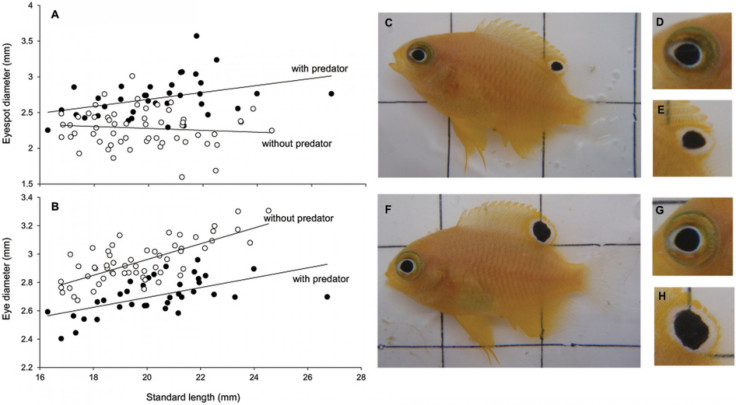Marine Illusionist: Tiny Fish Grow False Eyes On Tails To Trick Predators When Under Threat

Certain prey fish, when they are young, have a big, false "eye" on their back fins to distract predators and thereby increase their chances of survival, new research reveals.
According to the study, conducted by researchers from Australia’s ARC Centre of Excellence for Coral Reef Studies, or CoECRS, small damsel fish can grow a larger eye-like spot near their tail when they are constantly facing the threat of being eaten.
The fish can also reduce the size of their real eyes to trick predators with fake ones that look exactly like eyes from a distance. The false eyes on the rear fins create an illusion, which makes the predator think that the fish is heading its way while, in fact, it is actually darting off in the opposite direction, said the study, which was recently published in the journal Scientific Reports.
“It’s an amazing feat of cunning for a tiny fish,” Oona Lonnstedt of CoECRS and James Cook University said, in a statement. “Young damsel fish are pale yellow in color and have this distinctive black circular ‘eye’ marking towards their tail, which fades as they mature. We figured it must serve an important purpose when they are young.”
According to researchers, there has been a debate whether false eyespots or similar circular marks on the body of prey animals play any role in protecting them from predators. The CoECRS team now says it has discovered clear evidence that small fish use these spots when under threat.
“We found that when young damsel fish were placed in a specially built tank where they could see and smell predatory fish without being attacked, they automatically began to grow a bigger eye spot, and their real eye became relatively smaller, compared with damsels exposed only to herbivorous fish, or isolated ones,” Lonnstedt said in the statement.
Researchers also conducted their study on a coral reef to investigate how the fish behave in nature and found that juvenile damsel fish with enlarged eye spots had five times the survival rate of fish with a normal-sized spot.
“We think the eyespots not only cause the predator to attack the wrong end of the fish, enabling it to escape by accelerating in the opposite direction, but also reduce the risk of fatal injury to the head,” Lonnstedt said.
In addition, when placed in proximity to a predator the young damsel fish also adopt certain protective behaviors, such as reducing activity levels, taking refuge more often and developing a chunkier body shape, which is difficult for a predator to swallow.
According to researchers, all these traits suggest that tiny fish have evolved many clever techniques for survival, which they deploy whenever the situation demands.
© Copyright IBTimes 2024. All rights reserved.






















